基于GaSe和GaSe0.7 S0.3单晶的单脉冲CO2激光倍频器
2011-05-11TARASENKOSITNIKOVPANChENKOATELMINOVGENIND李殿军张来明谢冀江SARKISOVSYuBEREZNAYASAKOROTChENKOZVKAZAKOV
TARASENKO V F,SITNIKOV A G,PANCh ENKOA N,TELˊMINOV A E,GENIND E,李殿军,张来明,姜 可,谢冀江,SARKISOV SYu,BEREZNAYA SA,KOROTCh ENKO ZV,KAZAKOV A V
(1.俄罗斯科学院西伯利亚分院强电流研究所,托木斯克634055,俄罗斯;
2.中国科学院长春光学精密机械与物理研究所,激光与物质相互作用国家重点实验室,吉林长春130033;
3.托木斯克州立大学西伯利亚物理技术研究所,半导体材料科学实验室,托木斯克634034,俄罗斯)
基于GaSe和GaSe0.7S0.3单晶的单脉冲CO2激光倍频器
TARASENKO V F1,SITNIKOV A G1,PANCh ENKOA N1,TELˊMINOV A E1,GENIND E1,李殿军2,张来明2,姜 可2,谢冀江2,SARKISOV SYu3,BEREZNAYA SA3,KOROTCh ENKO ZV3,KAZAKOV A V3
(1.俄罗斯科学院西伯利亚分院强电流研究所,托木斯克634055,俄罗斯;
2.中国科学院长春光学精密机械与物理研究所,激光与物质相互作用国家重点实验室,吉林长春130033;
3.托木斯克州立大学西伯利亚物理技术研究所,半导体材料科学实验室,托木斯克634034,俄罗斯)
描述了使用电感储能发生器和半导体转换开关泵浦的工作波长为10.6μm的高效CO2激光器。给出了激光泵浦的非线性晶体GaSe和GaSe0.7S0.3的二次谐波振荡的实验数据和理论估算结果。结果显示,GaSe晶体在输入能量为180 mJ时,最大能量转换效率为0.38%,倍频激光的峰值功率为8 kW。
GaSe;GaSe0.7S0.3;单脉冲CO2激光;倍频器
1 Introduction
An efficient high-power short-pulse CO2laser with an inductive energy storage generator and a semiconductor opening swich on the basis of SOS-diodeswas tuned to generate TEM00mode at the wavelength of 10.6μm.The inductive energy storage generator easily allows to form a laser pulse with the short spike about 50 ns in duration(FWhM)and 1μs tale.
In order to demonstrate the possibility to obtain coherent radiation at other wavelengths,we employed Second h armonic Generation(Sh G)process in nonlinear crystals.Atour disposalwe had centimeter-sixe GaSe and GaSe0.7S0.3crystals which were well known to be efficient nonlinear crystals formid IR and terahertx range conversion[1-3].
2 Theory
To set up the frequency doubler for our CO2laser,first of all we performed a choice of nonlinear crystals and type of interaction.The phase-matching curves were obtained by using dispersion relations from[4]for GaSe and from [5]for GaSeS(see Fig.1).
The Sh G output power is proportional to the merit factors,plotted in Fig.2.According to Fig.2,the I type of interaction in both crystals requires lower phase-matching angles and corresponds to higher merit factors.When calculating curves in Fig.2,we assumed that d22component of nonlinearity of the second order for both crystals is equal to 54 pm/V.
Efficient nonlinearities depend on the polarixation and orientation of interacting beams and are expressed as deff= -d22×cosθ×sin3φ and deff= d22×cos2θ×cos3φfor the first and second types of interaction,respectively.

Fig.1 Internal phase-matching angles for Sh G in GaSe and GaSe0.7 S0.3 crystals on Iand II types of interaction.The dispersion relations from[4]and[5]were used.
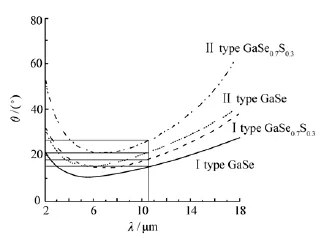
Fig.2 Merit factors for GaSe and GaSe0.7 S0.3 crystals on Iand II types of interaction.The dots represent points related to phase-matching angles.
According to the above calculations,the I type of interaction ismore efficient,so we performed our experiments in this configuration.The polarixation of the laserwas vertical and the nonlinear crystalswere rotated around vertical axis for phase-matching.
Calculation of the second harmonic radiation power PShGwasmade on the assumption of low conversion efficiency without depletion of the pumping power by using the well-known relation:

where d is the length of crystal,PCO2is an emission power of CO2laser,nCO2,nSGhare refractive indexes at a wavelength of CO2laser and second harmonic,respectively,S is cross-sectional area of the laser beam,c is the speed of light,ε0is a dielectric constant andΔk is the wave detuning.
Thus,the estimationsmade predict that higher efficiency of Sh G in GaSe0.7S0.3can be expected.On the other hand,the real nonlinearity in these crystals can be lower than that in GaSe.In our experiments,we achieved higher conversion efficiency in pure GaSe,but these crystalswere thicker.
3 Experimental technique and measurement procedure
The high-power single-pulse CO2laser pumped by the generator with semiconductor opening switch based on SOS-diodes[6]was used in our experiments for pumping crystals at the wavelength of 10.6μm.Schematic diagram of the laser is shown in Fig.3.
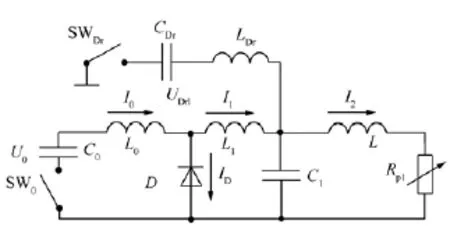
Fig.3 Pumping scheme of CO2 laser:R pl is discharge resistance;SW0 and SWDr are spark dischargers;C0=70 nF is storage capacitor;C1=2.45 nF is peaking capacitor;C Dr=10 nF is a capacitor for the forward pumping of SOS diodes;L0 =24.5 nh,L1=11 nh,L Dr=3.1μh are inductances of the circuits;U0 and U Dr are charging voltages;I is currents in the circuits.
The pump generator included themain and auxiliary circuits.The main circuit consisted of a storage capacity C0and an inductance L0.The auxiliary circuitwas used for preliminary forward pumping of SOS diodes and included a capacitor CDrand an inductance LDr.The energy stored in the auxiliary circuit was2 J.In the laser,we used ten SOS-50-2 diodes positioned parallel to the peaking capacitors.The gas-discharge gap was preionised by the radiation from 72 spark gaps uniformly positioned from both sides of the anode,which were triggered by pulse charging of the peaking capacity C1.The generator could operate both in the IES regime and a conventional LC generator.In the latter case,the capacitor CDrwas not charged.The active laser volume V was 2 cm×2 cm×70 cm.
The laser output energy wasmeasured by using an OPh IR calorimeter with FL-250A or PE-50BB sensors.The laser pulse waveforms were measured with a Ge-Au photoresistor of the FSG-33-3A1 type.Electrical signals were recorded with a TDS-3034 digital oscilloscope.
Optical cavity was formed by a Cu mirror and a TlBr plate.In the radiation conversion experiments,optical cavity includes a totally reflecting aluminum mirror with a radius of curvature 5 m and a plate of TlBr.Polarixed radiation was obtained by using a NaCl plate placed at the Brewster angle between the lasermirrors.In order to form single-mode laser radiation,an aperturewith a diameter of7mm was introduced into the laser optical cavity.
A Sh G experiment was carried out as follows.The laser beam radiates on the crystal at 10.6μm.To cut radiation ShG at a wavelength of 5.3μm from transmitted through the crystal laser radiation,a sapphire filter was used.The coefficient of transparency of the filter at a wavelength of 5.3μm is measured to be 43%.
4 Experimental results and discussion
4.1 Laseroperation
Comparison of laser excitation by different generators is shown in Fig.4(a).A sharp cutoff of the current through the semiconductor diodes begins 25 ns after the start of the storage capacitor discharge shown in Fig.4(b).During this time,the energy portion EL=L0I2/2(where I is the amplitude of the cutoff current)is transferred to the IES(inductance L0).The current through the diodes completely ceases after 75 ns,during which the energy dissipated in them reaches 6 J.At the cutoff instant,the current in the IESswitches to charge the peaking capacitors.As a result,the IES for the time of~10 ns charges the capacity C1to a voltage exceeding 70 kV,thus forming a high-voltage pre-pulse across the laser gap.After the laser gap breakdown,the residual IES current is summed with the current I1flowing through the peaking capacitor,which provides a rapid increase in the discharge current and ensures the formation of a short high-power pump pulse.Then,the main part of the energy stored in the capacitor C0is deposited to the medium.The high overvoltage and the fast increase in the current,as this occurred in Ref.[6-9],allow formation of a stable volume discharge in CO2laser mixtures with high pressures and large concentrations of the molecular component.It is seen from the shape of the discharge current pulse(Fig.4(a)).Approximately 120 ns after the pumping start,the current in the laser gap begins to exponentially decrease and the discharge extinguishes after the next~500 ns.In this process,similar to the case with h F(DF)lasers, the storage capacitor can be discharged incompletely.The radiation pulse also contains a short peak with a half-height duration of 40-50 ns and a peak power of up to 45 MW,which is followed by a tail whose duration depends on the working mixture composition.In themixture h e∶CO2∶N2= 3∶1∶1,the total laser pulse duration is~1μs,and its first peak contains 35%of the radiation energy.With increasing themolecular component concentration in themixture or replacement of h e by h2,the part of the radiation energy in the first peak increases to 70% and the pulse duration decreases to 700 ns.
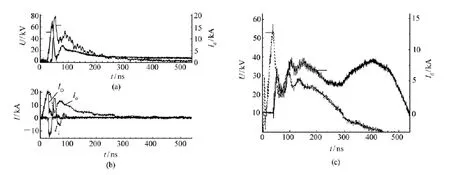
Fig.4 Oscillograms of voltage pulses across the laser gap(U),current in the laser gap(I d),current through the diodes(I SOS),and currents in the circuits of the storage(I0)and peaking(I1)capacitors.The h e∶CO2∶N2=3∶1∶1 mixture at p≈101 kPa was pumped by a generatorwith an SOS((a),(b);I=20 kA,E L=5 J)and an LC generator(c).The charging voltage of the storage capacitor is U0=36 kV.
If the laser is pumped with the use of an LC generator(Fig.4(c)),the peaking capacitor C1is charged only from the storage capacitor,which increases the rise time of the voltage across the laser gap to~40 ns and decreases the laser gap breakdown voltage to 57 kV;the amplitude of the first pump peak simultaneously decreases twofold.Therefore,the energy in the first peak of the laser pulse decreases and the first peak duration increases.In addition,the switching off of the SOS leads to a loss of the discharge stability.In 250 ns after the laser gap breakdown,one observes a sharp increase in the current and a decrease in the laser gap voltage,which is typical of the transition of the volume discharge to the spark stage.In all the studied gasmixtures,with decreasing the charge voltage of the storage capacitor of the LC generator,the discharge contraction occurs20-100 ns after the laser gap breakdown,which leads to a sharp decrease in the laser radiation energy.When the CO2laser is pumped by an LC generator,the voltage across the laser gap in the quasi-steady-state stage of the discharge noticeably increases.In the case of an IES,at maximum U0,approximately half the energy is deposited to the active medium at the optimum parameter E/p<0.1 V·cm-1·Pa-1,where E is the electric field strength[10].
In the case of an LC generator,themain energy contribution ismade at E/p≈0.15 V·cm-1·Pa-1.An increase in E/p and the development of instabilities in the volume discharge noticeably decrease the lasing efficiency.For the conditions of Fig.4,at U0=36 kV,the energy deposited to the activemedium is 31 J.With the use of the IES,the lasing energy is Q=6.2 J,which corresponds to the internal efficiency(with respect to deposited energy)of the CO2laserηint=20%,while electrical efficiency(with respect to stored energy)is as high asη0=14%.In the case of the LC generator,Q=2 J andηintdoes not exceed 7%.
4.2 Radiationconversion
Peak radiation power at maximal laser output(45 MW)is very high for nonlinear crystals because their damage threshold wasmeasured to be not higher than 25 MW/cm2.Therefore working mixture of the h2∶CO2∶N2=2∶4∶1 composition at a total pressure of0.7 atm was used.In this case,the laser energy was180 mJ.The laser pulsewaveform is shown in Fig.5.As in the case of h e containing mixture,duration of the first peak was50 ns(FWhM)and about 50%of the total energy was emitted in that peak.Measurement of the laser beam intensity profile shows that the profile is consistentwith a Gaussian with a beam radius of3 mm by the level of intensity e-2.

Fig.5 Waveform of laser pulse power.

Fig.6 Temporal behaviour of Sh G radiation power for GaSe
In the case(see curve 1)of the Fig.6,the crystals allow to obtain radiation at 5.3μm via I-type Sh G process with considerable power even without focusing of the pump radiation.The specific laser energy on the crystal surfacewas2 J/cm2.According to Eq.(1),the increase of the incident laser power should result in higher conversion efficiencies.Laser radiation was focused on the crystal by using NaCl lenswith f=234 mm.Distance from the lens to the crystal Ldis 12 cm.In this case,peak power of the converted radiation was doubled and reached 8 kW for GaSe(see curve 2).
Fig.7 depicts power conversion efficiency for GaSe calculated as the ratio between power of converted radiation and laser power in the same instant =PShG/Plasobtained with a lens.It is seen that the maximal conversion efficiency is observed during first~200 ns of the laser pulse.The efficiency was maximal during the laser pulse and was as high as 0.5%.Note that radiation conversion was observed during the whole laser pulse including its tale.h owever,efficiency was lower by one order of magnitude.Maximal energy conversion efficiency obtained in our experiments reached 0.38%.From 180 m Jof the incident radiation 0.7 m J at a wavelength of 5.3μm was obtained.
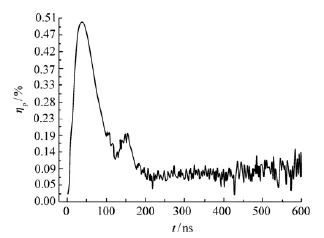
Fig.7 Power conversion efficiency for GaSe crystal obtained with the lens.
We alsomeasured the dependences of Sh G output power on aximuth angleφ(see Fig.8)and on incidence angleθ(see Fig.9)for GaSe crystal.As is seen from Fig.6,aximuth angle corresponding to the maximum Sh G power is measured to be 34°.Calculated and experimental angular dependences of the converted radiation power are in good match.Themeasured synchronism angle is 44.8°,and the calculated one is 44.5°.Widths at halfmaximum of the experimental and theoretical angular dependences of the Sh G power were equal to 1.1°(see Fig.9).
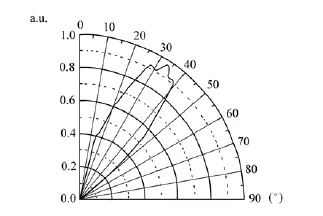
Fig.8 Measured dependence of Sh G output power on aximuth angleφfor GaSe.

Fig.9 Dependence of Sh G output power on incidence angleθfor GaSe
Unfortunately,the Sh G power for GaSe0.7S0.3was notmeasured due to low energy resolution of the experimental apparatus.We estimates that the Sh G power was about one order ofmagnitude lower than that for GaSe.Low ShG power for GaSe0.7S0.3corresponds to theoretical estimation by using Eq.(1).GaSe0.7S0.3crystal had a length of d=3.7 mm as compared to 10 mm for GaSe crystal.The efficiency is proportional to the d2resulting in one order effi-ciency decrease for three-fold lower crystal thickness.
Comparison of the Sh G efficiency in GaSe0.7S0.3and GaSe crystals should be made either with the crystalswith the same length,or with increased conversion efficiency,such as shorter laser pulses.In our further experiments,we plan to convert emission lines of the CO2laser into a Th x range.
5 Conclusions
An efficient CO2laser pumped by a generator and a semiconductor opening switch was developed.The experiments of radiation conversion at 5.3μm in nonlinear GaSe and GaSe0.7S0.3crystals were performed.
[1]SARKISOV SYu,NAZAROV M M,Sh KURINOV A P,etal..GaSe1-xSxand GaSe1-xTsxsolid solutions for terahertx generation and detection[C]In Proceedings of the 34th International Conference on Infrared Millimeter and Terahertx Wave(IRMMW-Th x-2009),Busan,Korea,21-25 Sept.2009.
[2]DASS,Gh OSh C,VOEVODINA OV,etal..Modified GaSe crystal as a parametric frequency converter[J].Appl.Phys.B.,2006,82(1):43-46.
[3]MANDAL K C,KANG S h,Ch OIM,et al..Ⅲ-Ⅵ chalcogenide semiconductor crystals for broadband tunable Th x sources and sensors[J].IEEE J.Selected Topics Quantum Electron.,2008,14(2):284-288.
[4]VODOPYANOV K L,KULEVSKIIL A.New dispersion relationships for GaSe in the 0.65-18m spectral region[J].Opt.Commun.,1995,118:375-378.
[5]ALLAh VERDIEV K R,GULIEV R I,SALAEV E Yu,et al..Investigation of linear and nonlinear optical properties of GaSxSe1-xcrystals[J].SoV.J.Quantum Electron.,1982,12(7):1483-1485.
[6]PANCh ENKO A N,ORLOVSKIIV M,TARASENKO V F.Spectral characteristics of nonchain h F and DF electric-discharge lasers in efficient excitation modes[J].Quantum Electron.,2004,34(4):320.
[7]PANCh ENKO A N,TARASENKO V F,TELˊMINOV E A.Efficient electric-discharge XeF laser pumped by a generator with an inductive energy storage[J].Quantum Electron.,2006,36(5):403-407.
[8]PANCh ENKO A N,SUSLOV A I,TARASENKO V F,et al..Laser on mixtures of nitrogen with electronegative gases pumped by a transverse discharge from a generatorwith inductive energy storage:Theory and experiment[J].Quantum E-lectron.,2007,37(5):433-439.
[9]ORLOVSKIIV M,PANCh ENKO A N,TARASENKO Y F.Electric-discharge high-peak-power CO2laser[J].Quantum Electron.,2010,40(3):192-194.
[10]LOBANOV A N,SUCh KOV A F,SOV J.Breakdown of the active medium in a CO2laser caused by its own radiation[J].Quantum Electron.,1974,4(12):1436-1442.
Authorˊs biography:TARASENKO V F(1946—),male,professor of Laboratory of Optical Radiation,Institute of h igh Current Electronics,Siberian Branch of the Russian Academy of Sciences.h ismain research field includes gas discharges with runaway electrons,UV and VUV spontaneous light sources,pulsed lasers on dense gases and applications.E-mail:alexei@loi.hcei.tsc.ru
Diagnosis of high-repetition-rate pulse laser with pyroelectric detector
Zh ANG Lei,Sh AO Bi-bo,YANG Peng-ling,WANG Zhen-bao,YAN Yan
(State Key Laboratory of Laser Interaction with Matter,Northwest Institute of Nuclear Technology,Xiˊan 710024,China)
Based on the working principles of a pyroelectric detector,the transient response of the detector to the pulse laser is researched.Themodel of pyroelectric detector is built,and the response in practical application is simulated according to the parameters ofmaterials and structures.Signal process circuitswhich are suitable for a high-repetition-rate pulse laser are designed.Finally,a number of the repetition frequency laser radiation experiments on the pyroelectric detector are carried out.The experiments on frequency response and pulse width of the detector are completed,and the feasibility of applying the pyroelectric detector to the energy measurement of the high-repetition-rate and narrow pulse laser is verified.
pyroelectric detector;high-repetition-frequency pulse;pulse laser signal;circuit of signal processing
2011-04-11;
2011-06-13
supported by the Federal Target Program“The scientific and Scientific-pedagogical Personnel of Innovative Russia”(No.02.740.11.04444);Russian President Grant(SS4297.2010.2).
book=398,ebook=82
TN248.2
A
book=404,ebook=88
1674-2915(2011)04-0404-07
